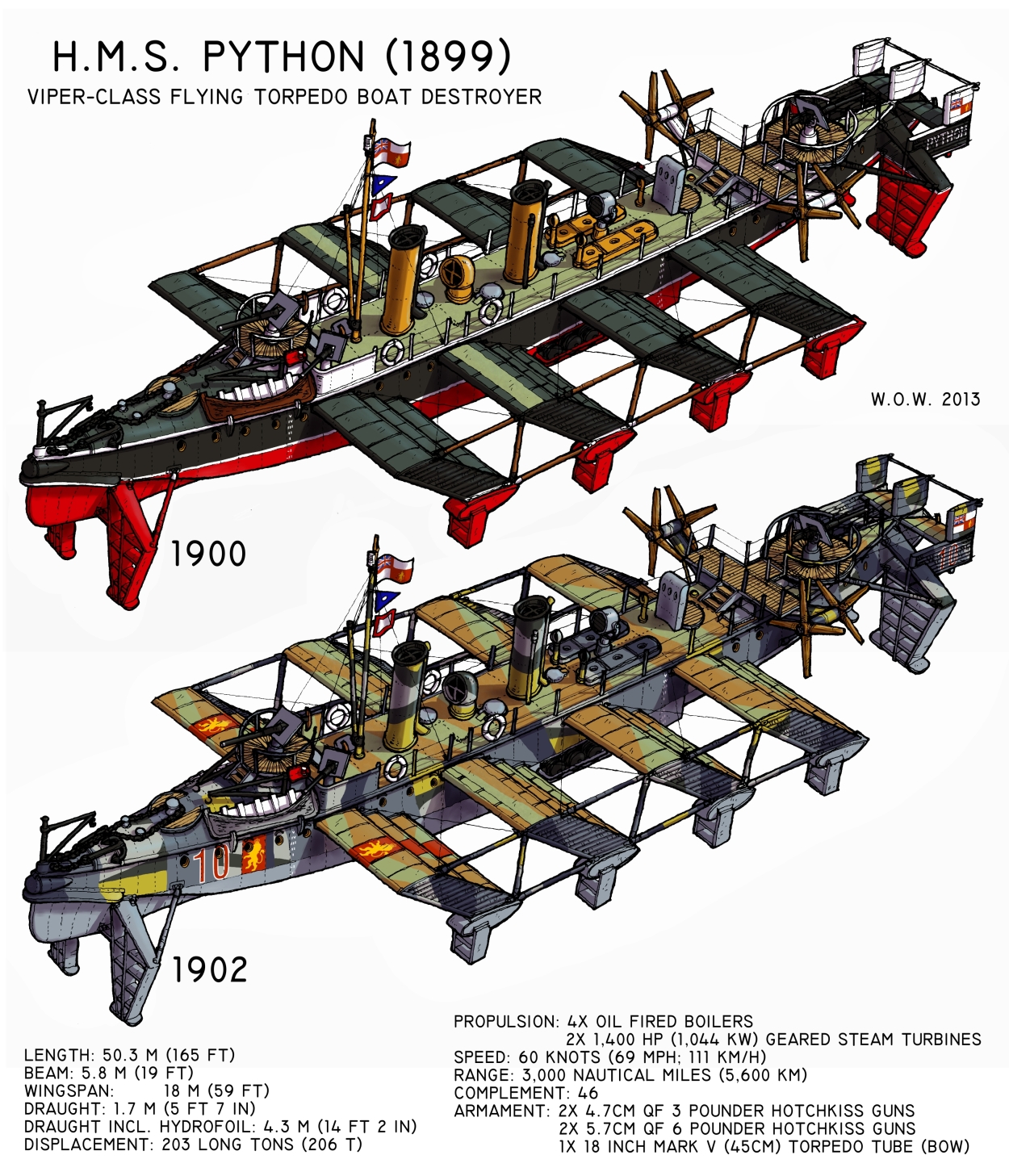ShopDreamUp AI ArtDreamUp
Deviation Actions
Suggested Deviants
Suggested Collections
You Might Like…
Featured in Groups
Description
EDIT, 05.02.14: Here you can find the French counterpart design.
Finally, I can say I finished with the design of the Shadowless flying ships. It's been a long road, and they went from steampunk flying ships to more realistic WIG - wing in ground effect, or "ekranoplans"- craft capable of skimming a few meters over over the waves rather than true flight. For examples of the earlier incarnations of these designs, you can see here.
The ship itself is based on the "torpedo boat destroyers" of the late 19th century with elements from the first hydrofoils. In real life, British boat designer John Thornycroft, the man who built the first torpedo boat for the British Royal Navy in 1876, also experimented with hydrofoils between 1899 and 1901, so it's not actually that far fetched that his experiments might have resulted into a craft like this, especially when paired with Sir Charles Parsons' 1884 invention of the steam turbine.
Basically, while the ship is at anchor it floats to the waterline, but, as it gathers speed, it rises out of the water, first on the hydrofoils and then completely out of the water, skimming 6 meters (20 ft) above the waves. To help the ship rise out from the water, the planing surface is stepped just forward of the aft wing set, another design feature first introduced in real life by John Thornycroft.
Propulsion is provided by two Parsons steam turbines connected via gear boxes (so there is no need for additional, "reversing" turbines and the propellers can be driven at a different speed to the turbines) to a pair of shafts containing two four bladed wooden aerial propellers each, set at 45 degrees to one another. The two shafts revolve in opposite directions, thus annulling any gyroscopic force that might arise.
Since flying uses a lot of fuel, for extended patrols the ship can cut power and drop back down on the hydrofoils, thus maintaining a cruise speed of "only" 40 knots.
There are two colour schemes presented, one based on the real life late Victorian "black, white and buff" livery and the other a wholly fictional camouflage design, however with colours used in real life by the RN during WW2.
The name, "HMS Python" was also used in real life for one of the members of the "Viper Class", the first turbine driven destroyers of the Royal Navy. Following the loss of the other two ships in accidents (HMS Viper foundered on rocks in fog during naval manoeuvres near Alderney on 3 August 1901, while HMS Cobra broke her back in a storm in the North Sea on 18 September 1901) HMS Python was renamed "Velox" and served until 1915 when she was sunk by hitting a German submarine deployed mine off the Isle of Wight.
Finally, I can say I finished with the design of the Shadowless flying ships. It's been a long road, and they went from steampunk flying ships to more realistic WIG - wing in ground effect, or "ekranoplans"- craft capable of skimming a few meters over over the waves rather than true flight. For examples of the earlier incarnations of these designs, you can see here.
The ship itself is based on the "torpedo boat destroyers" of the late 19th century with elements from the first hydrofoils. In real life, British boat designer John Thornycroft, the man who built the first torpedo boat for the British Royal Navy in 1876, also experimented with hydrofoils between 1899 and 1901, so it's not actually that far fetched that his experiments might have resulted into a craft like this, especially when paired with Sir Charles Parsons' 1884 invention of the steam turbine.
Basically, while the ship is at anchor it floats to the waterline, but, as it gathers speed, it rises out of the water, first on the hydrofoils and then completely out of the water, skimming 6 meters (20 ft) above the waves. To help the ship rise out from the water, the planing surface is stepped just forward of the aft wing set, another design feature first introduced in real life by John Thornycroft.
Propulsion is provided by two Parsons steam turbines connected via gear boxes (so there is no need for additional, "reversing" turbines and the propellers can be driven at a different speed to the turbines) to a pair of shafts containing two four bladed wooden aerial propellers each, set at 45 degrees to one another. The two shafts revolve in opposite directions, thus annulling any gyroscopic force that might arise.
Since flying uses a lot of fuel, for extended patrols the ship can cut power and drop back down on the hydrofoils, thus maintaining a cruise speed of "only" 40 knots.
There are two colour schemes presented, one based on the real life late Victorian "black, white and buff" livery and the other a wholly fictional camouflage design, however with colours used in real life by the RN during WW2.
The name, "HMS Python" was also used in real life for one of the members of the "Viper Class", the first turbine driven destroyers of the Royal Navy. Following the loss of the other two ships in accidents (HMS Viper foundered on rocks in fog during naval manoeuvres near Alderney on 3 August 1901, while HMS Cobra broke her back in a storm in the North Sea on 18 September 1901) HMS Python was renamed "Velox" and served until 1915 when she was sunk by hitting a German submarine deployed mine off the Isle of Wight.
Image size
1250x1457px 955.82 KB
© 2013 - 2024 wingsofwrath
Comments45
Join the community to add your comment. Already a deviant? Log In
intriguing design idea, so it's a hydrofoil warship? these things would be like a nightmare out of hell to enemy ships

































